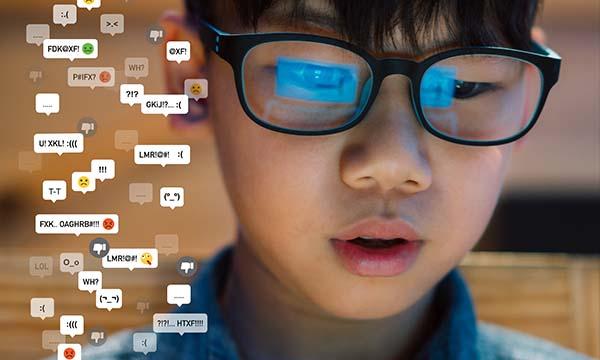Every single social media post potentially has the power to impact not only the person who created it, but also their friends or followers. Imagine that your child uploads a random selfie, but little do they know it would trigger somebody to comment on it with irrational insults and slurs. This person might be a troll or a cyberbully and may hurt your child. Therefore, awareness is key and the burdens of the online are worth discussing – even with young children.
What is cyberbullying?
Cyberbullying is a form of psychological harassment when aggressors use any electronic or digital technology. It is intentionally abusive behavior intended to hurt someone, which tends to occur repeatedly and systematically. This term includes various types of online abuse that can take place anywhere from online forums to videogames. There are many types of cyberbullying, even though the signs may not be obvious at first glance.
The so-called catfishing, fraping, outing, and cyberstalking are only a few examples. Cyberbullies can be even harder to escape than bullies in school. Also, as the content used for cyberbullying might had been saved and redistributed, it is often impossible track it down fully. The notion of so many people being able to view bullying content, and the feeling of insecurity, helplessness or shame that accompanies it can be psychologically devastating. Studies conducted by the Journal of Adolescent Health show that children affected by cyberbullying are more likely to experience depression than victims of common bullying.
In recent years, a large part of education has moved to the online environment. Children now spend more time on the internet, and face even greater risk of being cyberbullied. According to the American Counseling Association, some anonymous cyberbullies have no real motive, and slander others on social media just for “fun”. It is easier said than done, but it is important to bear in mind that, generally speaking, cyberbullying has nothing personal to do with the victim. On the contrary, it is mainly motivated by the bullies’ issues, and by the ways in which they seek to reconcile them.
The lure of anonymity
Social media such as Instagram and Facebook have become the most common places for cyberbullying. Why do so many people, including kids and teens, systematically hurt their peers online, even though they might never be so daring as to do it face to face?
We can look for answers in studies conducted by the renowned psychologist Philip Zimbardo. Participants of the infamous Stanford Prison Experiment who had their faces covered indulged in worse behaviors than their associates whose identities were not hidden. A similar concept applies to social media.
How is it possible that people act differently when they’re online? The answer is the disinhibitory effect, which is typical for online communication. It describes a kind of uncontrolled and far too relaxed behavior that is due to a limitation on the ability to empathize with their communication partner because they are not able to see them, as well as a perceived anonymity and a feeling like the person (the bully) is immune to any consequences of their behaviour. Also, the communication is asynchronous, it does not take place in real time, and is immune to interruption. The disinhibitory effect intensifies or triggers many forms of online aggression – from cyberbullying and hate speech to trolling.
If your child falls victim to cyberbullying, they should not remain silent. Sharing what is on their mind with someone they trust is the first important step to resolving the situation. Teachers, close friends, and especially family members can prevent the problem from getting worse.
Read more: Is your child being cyberbullied? These are the red flags

What can parents do to prevent and solve cyberbullying?
1. Private means safe
When it comes to the online world, always think about the privacy of yourself and your children. Remind them not to publicize their date of birth, address, full name, or other personal information unless it is absolutely necessary. You as well as your kids should preferably keep all their profiles private.
Social media against cyberbullying
Last year, TikTok became the most visited website on the internet, and exceptionally popular among teenagers. Due to the growing number of users and accompanying vulgar comments, TikTok introduced new features to prevent cyberbullying. Content creators now have the ability to approve comments before they get published and their followers can report users who express signs of cyberbullying. Instagram also stands strongly against online bullying, with features such as word filters, and comment warnings, as well as systems for reporting posts and blocking accounts.
2. Let kids have various hobbies
Help your children build high-quality relationships online and off. Also, support them to develope a strong identity. Remember that kids should not only spend their free time online, but also engage in a wide range of offline activities. The more diverse their life is the happier they will be, with more meaningful relationships and fewer enemies.

3. Know how to approach a cyberbully and a troll
Trolls desire a direct answer. They are waiting for a response so they can inflict another blow. If their target doesn’t interact, trolls usually lose interest.
On the other hand, cyberbullies’ strategies are more complex. Humiliating other people satisfies the aggressor, regardless of whether they respond or not. Another important difference from the troll is that the cyberbully is often somebody the victim knows personally from the offline world, which may be even more hurtful.
If they fall victim to a cyberbully, your child should know to disengage immediately. The cyberbully should be reported to the specific network, which raises the probability that their profile will be deactivated. If this does not help, the cyberbully should be at least blocked so that they cannot contact your children. If you find out about the problem at a later stage, try to save as much as evidence possible before the cyberbully deletes it. It is always a good idea to take screenshots whenever your child witnesses any signs of cyberbullying or trolling online.
When it comes to coping strategies for victims of cyberbullying, the most effective solutions include blocking the contact, avoiding the social network or website and seeking support. It is helpful for the victims to delete their accounts, or at least change their profiles.
All in all, always try to talk to your children about what cyberbullying actually means. Prepare them for the risks they may face in the digital world. Explain to them how they should approach social media and what to avoid. Let them know it is okay to seek support and help – and that from time to time, everyone gets trapped. Even adults.




